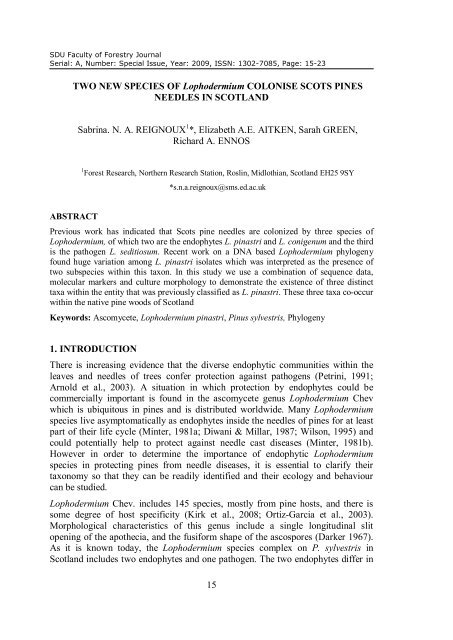sdu faculty of forestry journal special edition 2009 - Orman Fakültesi
sdu faculty of forestry journal special edition 2009 - Orman Fakültesi
sdu faculty of forestry journal special edition 2009 - Orman Fakültesi
You also want an ePaper? Increase the reach of your titles
YUMPU automatically turns print PDFs into web optimized ePapers that Google loves.
SDU Faculty <strong>of</strong> Forestry Journal<br />
Serial: A, Number: Special Issue, Year: <strong>2009</strong>, ISSN: 1302-7085, Page: 15-23<br />
TWO NEW SPECIES OF Lophodermium COLONISE SCOTS PINES<br />
NEEDLES IN SCOTLAND<br />
ABSTRACT<br />
Sabrina. N. A. REIGNOUX 1 *, Elizabeth A.E. AITKEN, Sarah GREEN,<br />
Richard A. ENNOS<br />
1 Forest Research, Northern Research Station, Roslin, Midlothian, Scotland EH25 9SY<br />
*s.n.a.reignoux@sms.ed.ac.uk<br />
Previous work has indicated that Scots pine needles are colonized by three species <strong>of</strong><br />
Lophodermium, <strong>of</strong> which two are the endophytes L. pinastri and L. conigenum and the third<br />
is the pathogen L. seditiosum. Recent work on a DNA based Lophodermium phylogeny<br />
found huge variation among L. pinastri isolates which was interpreted as the presence <strong>of</strong><br />
two subspecies within this taxon. In this study we use a combination <strong>of</strong> sequence data,<br />
molecular markers and culture morphology to demonstrate the existence <strong>of</strong> three distinct<br />
taxa within the entity that was previously classified as L. pinastri. These three taxa co-occur<br />
within the native pine woods <strong>of</strong> Scotland<br />
Keywords: Ascomycete, Lophodermium pinastri, Pinus sylvestris, Phylogeny<br />
1. INTRODUCTION<br />
There is increasing evidence that the diverse endophytic communities within the<br />
leaves and needles <strong>of</strong> trees confer protection against pathogens (Petrini, 1991;<br />
Arnold et al., 2003). A situation in which protection by endophytes could be<br />
commercially important is found in the ascomycete genus Lophodermium Chev<br />
which is ubiquitous in pines and is distributed worldwide. Many Lophodermium<br />
species live asymptomatically as endophytes inside the needles <strong>of</strong> pines for at least<br />
part <strong>of</strong> their life cycle (Minter, 1981a; Diwani & Millar, 1987; Wilson, 1995) and<br />
could potentially help to protect against needle cast diseases (Minter, 1981b).<br />
However in order to determine the importance <strong>of</strong> endophytic Lophodermium<br />
species in protecting pines from needle diseases, it is essential to clarify their<br />
taxonomy so that they can be readily identified and their ecology and behaviour<br />
can be studied.<br />
Lophodermium Chev. includes 145 species, mostly from pine hosts, and there is<br />
some degree <strong>of</strong> host specificity (Kirk et al., 2008; Ortiz-Garcia et al., 2003).<br />
Morphological characteristics <strong>of</strong> this genus include a single longitudinal slit<br />
opening <strong>of</strong> the apothecia, and the fusiform shape <strong>of</strong> the ascospores (Darker 1967).<br />
As it is known today, the Lophodermium species complex on P. sylvestris in<br />
Scotland includes two endophytes and one pathogen. The two endophytes differ in<br />
15








